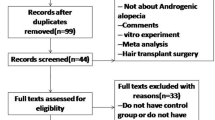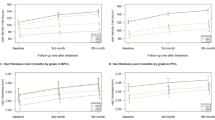Abstract
Background
Androgenetic alopecia (AGA) is a common hair disorder that affects both men and women all over the world. Although it is far from being a life-threatening disease, the psychosocial impact of AGA can provoke stress and a significant decrease in life quality. The objective of this retrospective study is to investigate the safety and efficacy of autologous plasma rich in growth factors (PRGF) for the treatment of AGA.
Methods
One hundred patients were included in this study. They followed two intradermal cycles of PRGF every 4 weeks. Macrophotographs and trichograms were performed at baseline and at 4 months after the first treatment in order to evaluate the overall improvement and determine the anagen/telogen hair ratio, respectively.
Results
Patients showed an overall increase in hair density. Trichogram analysis showed that anagen hair follicles increased significantly at 6.2 percentage points (p < 0.05) comparing to baseline levels, while a decrease of 5.1 points (p < 0.05) was observed among telogen ones. No adverse effect was reported by any patient.
Conclusions
Although more randomized clinical studies are needed, our data suggest that PRGF has a positive therapeutic effect on androgenetic alopecia showing no adverse effects related to the treatment protocol.
Level of Evidence: Level III, therapeutic study.




Similar content being viewed by others
References
Hamilton JB (1951) Patterned loss of hair in man: types and incidence. Ann N Y Acad Sci 53:708–728
Norwood OT (2001) Incidence of female androgenetic alopecia (female pattern alopecia). Dermatol Surg 27:53–54
Sawaya ME, Price VH (1997) Different levels of 5α-reductase type I and II, aromatase and androgen receptor in hair follicles of women and men with androgenetic alopecia. J Invest Dermatol 109:296–300
Blume-Peytavi U, Blumeyer A, Tosti A, Finner A, Marmol V, Trakatelli M, Reygagne P, Messenger A (2011) S1 guideline for diagnostic alopecia in men, women and adolescents. Br J Dermatol 164:5–15
de Koning EB, Passchier J, Dekker FW (1990) Psychological problems with hair loss in general practice and the treatment policies of general practitioners. Psychol Rep 67:775–778
Duarte V, de Sousa IC, Tosti A (2013) New investigational drugs for androgenetic alopecia. Expert Opin Investig Drugs 22:573–589
Georgala S, Befon A, Maniatopoulou E, Georgala C (2007) Topical use of minoxidil in children and systemic side effects. Dermatology 214:101–102
Irwig MS, Kolukula S (2011) Persistent sexual side effects of finasteride for male pattern hair loss. J Sex Med 8:1747–1753
Toyoshima KE, Asakawa K, Ishibashi N, Toki H, Ogawa M, Hasegawa T, Irié T, Tachikawa T, Sato A, Takeda A, Tsuji T (2012) Fully functional hair follicle regeneration through the rearrangement of stem cells and their niches. Nat Commun 3:784
Jang JH (2005) Stimulation of human hair growth by the recombinant human keratinocyte growth factor-2 (KGF-2). Biotechnol Lett 27:749–752
Kang JS, Zheng Z, Choi MJ, Lee SH, Kim DY, Cho SB (2014) The effect of CD34+ cell containing autologous platelet rich plasma injection on pattern hair loss: a preliminary study. J Eur Acad Dermatol Venereol 28:72–79
Takikawa M, Nakamura S, Nakamura S, Ishirara M, Kishimoto S, Sasaki K, Yanagibayashi S, Azuma R, Yamamoto N, Kiyosawa T (2011) Enhanced effect of platelet rich plasma containing a new carrier on hair growth. Dermatol Surg 37:1721–1729
Anitua E, Sánchez M, Prado R, Orive G (2014) The type of platelet-rich plasma may influence the safety of the approach. Knee Surg Sports Traumatol Arthrosc 22:1708–1709
Anitua E, Sánchez M (2012) We cannot take oranges for apples in the field of platelet-rich plasma products. Scand J Med Sci Sports 22:147–148
Anitua E, Zalduendo MM, Alkhraisat MH, Orive G (2013) Release kinetics of platelet-derived and plasma-derived growth factors from autologous plasma rich in growth factors. Ann Anat 195:461–466
Anitua E, Alonso R, Girbau C, Aguirre JJ, Muruzabal F, Orive G (2012) Antibacterial effect of plasma rich in growth factors (PRGF-Endoret) against Staphylococcus Aureus and Staphylococcus Epidermidis strains. Clin Exp Dermatol 37:652–657
Anitua E, Aguirre JJ, Algorta J, Ayerdi E, Cabezas AI, Orive G, Andia I (2008) Effectiveness of autologous preparation rich in growth factors for the treatment of chronic cutaneous ulcers. J Biomed Mater Res B Appl Biomater 84:415–421
Orcajo B, Muruzabal F, Isasmendi MC, Gutierrez N, Sánchez M, Orive G, Anitua E (2011) The use of plasma rich in growth factors (PRGF-Endoret) in the treatment of a severe mal perforant ulcer in the foot of a person with diabetes. Diabetes Res Clin Pract 93:65–67
Anitua E, Sanchez M, Sarabia R, Sanz J, Aguirre JJ, Orive G (2011) Eficacia y seguridad del PRGF(plasma rico en factores de crecimiento) en la regeneración cutanea facial. Ensayo clínico, randomizado y controlado con ácido hialurónico. AECEP 23–33.
Sánchez M, Fiz N, Azofra J, Usabiaga J, Aduriz Recalde E, Garcia Gutierrez A, Albillos J, Gárate R, Aguirre JJ, Padilla S, Orive G, Anitua E (2012) A randomized clinical trial evaluating plasma rich in growth factors (PRGF-Endoret) versus hyaluronic acid in the short term treatments of symptomatic knee osteoarthritis. Arthroscopy 28:1070–1078
Anitua E, Sanchez M, Nurden AT, Zalduendo M, de la Fuente M, Orive G, Azofra J, Andia I (2006) Autologous fibrin matrices: a potential source of biological mediators that modulate tendon cell activities. J Biomed Mater Res A 77:285–293
Sánchez M, Anitua E, Azofra J, Andía I, Padilla S, Mujika I (2007) Comparison of surgically repaired Achilles tendon tears using platelet rich fibrin matrices. Am J Sports Med 35:245–251
Panda A, Jain M, Vanathi M, Velpandian T, Khokhar S, Dada T (2012) Topical autologous platelet rich plasma eyedrops for acute corneal chemical injury. Cornea 31:989–993
Anitua E, Sanchez M, Merayo-Lloves J, De la Fuente M, Muruzabal F, Orive G (2011) Plasma rich in growth factors (PRGF-Endoret) stimulates proliferation and migration of primary keratocytes and conjunctival fibroblasts and inhibits and reverts TGFβ1 induced myodifferentiation. Invest Ophthalmol Vis Sci 52:6066–6073
Anitua E, Muruzabal F, Pino A, Merayo-Lloves J, Orive G (2013) Biological stability of plasma rich in growth factors eye drops after storage of 3 months. Cornea
Anitua E, Pascual C, Pérez-Gonzalez R, Antequera D, Padilla S, Orive G, Carro E (2013) Intranasal delivery of plasma and platelet growth factors using PRGF-Endoret system enhances neurogenesis in a mouse model of Alzheimer’s disease. PLoS One 8:73118
Anitua E, Begoña L, Orive G (2012) Treatment of hemimandibular paresthesia in a patient with bisphosphonate-related osteonecrosis of the jaw (BRONJ) by combining surgical resection and PRGF-Endoret. Br J Oral Maxillofac Surg 51:272–274
Barrientos S, Stojadinovic O, Golinko MS, Brem H, Tomic-Canic M (2008) Growth factors and cytokines in wound healing. Wound Repair Regen 16:585–601
Yang HS, Shin J, Bhang SH, Shin JY, Park J, Im GI, Kim CS, Kim BS (2011) Enhanced skin wound healing by a sustained release of growth factors contained in platelet rich plasma. Exp Mol Med 43:622–629
Anitua E, Zalduendo MM, Prado R, Alkhraisat MH, Orive G (2014) Morphogen and proinflamatory cytokine release kinetics from PRGF-Endoret fibrin scaffolds: evaluation of the effect of leukocyte inclusion. J Biomed Mater Res A
Chen FM, Zhang M, Wu ZF (2010) Toward delivery of multiple growth factors in tissue engineering. Biomaterials 31:6279–308
Rendu F, Brohard-Bohn B (2001) The platelet release reaction: granules’ constituents, secretion and functions. Platelets 12:261–73
Gurtner GC, Werner S, Barrandon Y, Longaker MT (2008) Wound repair and regeneration. Nature 453:314–321
Madeddu P (2005) Therapeutic angiogenesis and vasculogenesis for tissue regeneration. Exp Physiol 90:315–326
Paus R, Cotsarelis G (1999) The biology of hair follicles. N Engl J Med 341:491–497
Yano K, Brown LF, Detmar M (2001) Control of hair growth and follicle size by VEGF mediated angiogenesis. J Clin Invest 107:409–417
Kamp H, Geilen CC, Sommer C, Blume-Peytavi U (2003) Regulation of PDGF and PDGF receptor in cultured dermal papilla cells and follicular keratinocytes of the human hair follicle. Exp Dermatol 12:662–672
Takakura N, Yoshida H, Kunisada T, Nishikawa S, Nishikawa SI (1996) Involvement of platelet derived growth factor receptor α in hair canal formation. J Invest Dermatol 107:770–777
Tosti A, Gray J (2007) Assessment of hair scalp disorders. J Investig Dermatol Symp Proc 12:23–27
Schneider MR, Schmidt-Ullrich R, Paus R (2009) The hair follicle as a dynamic miniorgan. Curr Biol 19:132–142
Serrano-Falcón C, Fernández-Pugnaire MA, Serrano-Ortega S (2013) Hair scalp evaluation: the trichogram. Actas Dermosifiliogr 104:867–876
Sclafani AP (2014) Platelet rich fibrin matrix (PRFM) for androgenetic alopecia. Facial Plast Surg 30:219–224
Trink A, Sorbellini E, Bezzola P, Rodella L, Rezzani R, Ramot Y, Rinaldi F (2013) Platelet rich plasma injection is effective and safe for the treatment of alopecia. Br J Dermatol 169:690–694
Schiavone G, Raskovic D, Greco J, Abeni D (2014) Platelet rich plasma for androgenetic alopecia: a pilot study. Dermatol Surg 40:1010–9
Li ZJ, Choi HI, Choi DK, Sohn KC, Im M, Seo YJ, Lee YH, Lee JH, Lee Y (2012) Autologous platelet rich plasma: a potential tool for promoting hair growth. Dermatol Surg 38:1040–1046
Rastegar H, Ahmadi Ashtiani H, Aghaei M, Ehsani A, Barikbin B (2013) Combination of herbal extracts and platelet rich plasma induced dermal papilla cell proliferation: involvement of ERK and Akt pathways. J Cosmet Dermatol 12:116–122
Conflict of interest
Eduardo Anitua and Ander Pino are scientists at BTI Biotechnology Institute. This biotechnology company has developed the technology of plasma rich in growth factors. Navarro MR, Asín M, Martínez AM, Molina C, Navarro V, and Orive G declare that they have no conflict of interest.
Ethical approval
All procedures performed in studies involving human participants were in accordance with the ethical standards of the institutional and/or national research committee and with the 1964 Helsinki declaration and its later amendments or comparable ethical standards.
This is a retrospective study, so for this type of study, formal consent is not required.
Patient consent
Patients provided written consent for the use of their images.
Author information
Authors and Affiliations
Corresponding author
Rights and permissions
About this article
Cite this article
Navarro, M.R., Asín, M., Martínez, A.M. et al. Plasma rich in growth factors (PRGF) for the treatment of androgenetic alopecia. Eur J Plast Surg 38, 437–442 (2015). https://doi.org/10.1007/s00238-015-1116-z
Received:
Accepted:
Published:
Issue Date:
DOI: https://doi.org/10.1007/s00238-015-1116-z




